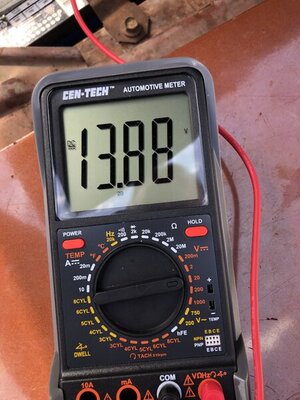need to do some testing to find the problem...
TROUBLESHOOTING---BOOK----
NO-LOAD TEST
This test will determine whether or not the system is charging the battery and, if not, whether the alternator or regulator is at fault. It requires a voltmeter capable of measuring at least 16 volts, down to tenths of a volt.
If the charging system on your car has an externally mounted regulator, warm up the engine before performing the following test:
1. Turn off the engine, lights, and all other accessories.
2. Attach an engine tachometer according to the manufacturer’s instructions.
3. Connect the voltmeter to the battery by attaching the positive lead to the positive terminal and the negative lead to the negative terminal.
4. Note the voltmeter reading. If it is less than 12 volts, charge the battery. Then note the voltage reading again and record it.
5. Start the engine and slowly increase the speed to 1,500 rpm.
6. Note the voltmeter reading again. If it exceeds the engine-off voltage by more than 2 volts, the system has a faulty regulator, a poor regulator ground, or a short circuit in the wiring between the alternator and regulator.
7. If this voltage reading exceeds the engine-off voltage by less than 2 volts, perform a load test.
LOAD TEST
1. Keep the tachometer and voltmeter connected as they were for no-load test.
2. Note and record the voltage reading.
3. Start the engine and turn on the heater (or air conditioner) at high speed. Turn on all lights and accessories.
4. Increase the engine speed to 3,000 rpm and note the voltmeter reading.
5. If this reading exceeds the engine-off voltage by 1/2 volt or more, the charging system is functioning properly.
6. If his reading exceeds the engine-off voltage by less than 1/2 volt, perform a full-field test.
FULL-FIELD TEST
When the regulator’s control function is bypassed, the alternator runs full-field. The method of bypassing the regulator differs, depending on the type of vehicle. For this reason, Step 1 of the full-field test changes from car to car, while the remaining steps are the same for all models.
1C. Chrysler models. Turn of the engine. Locate the green wire connecting the alternator field terminal to the regulator; disconnect this wire from the alternator. Connect a jumper wire from the alternator field terminal to a good ground.
2. Once the regulator has been bypassed, repeat the load test.
3. If the full-field voltage exceeds the engine-off voltage by 1/2 volt or more, the regulator is defective and must be replaced...............do not jump the green wire to anything.
REGULATOR REPAIR
Once it has been determined that the problem is with the regulator and not the alternator, you can find out if the source is the regulator itself or its wiring or ground.
1. Check the wiring between the regulator and alternator for heat damage or wear. The regulator is usually mounted on the firewall or on the finder under the hood.
2. Remove the bolts from the voltage regulator.
3. Use sandpaper to clean off the area around the bolts and the spot where the voltage regulator mounts on the car. This will assure a good ground.
4. Clean, reinstall, and tighten the bolts.
5. Perform all of the troubleshooting procedures again to see if the problem still exists.
6. If so, the problem is either in the wiring or the regulator itself. If you have already inspected the wiring, try replacing the regulator
The Quick and Dirty Charging System Test
Remove the (+) FLD wire from the alternator.
Put a temporary jumper wire from the same (+) FLD terminal to the large output post on the alternator (battery +).
Start the car and see if it charges. If it does… good alternator. If not … bad alternator. If it did charge, then the voltage regulator is the problem child.
Turn the ignition key to the on position. Check for power on the small IGN terminal of the regulator. If there is, then see if there is any power on the other voltage regulator post to the alternator. A bad ground on the voltage regulator case is a very common problem. If not then you need to chase down the IGN power issue.

















